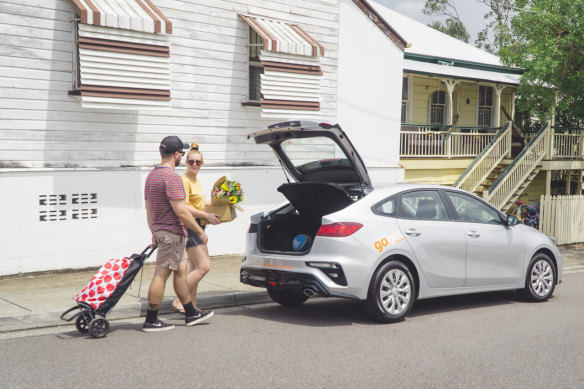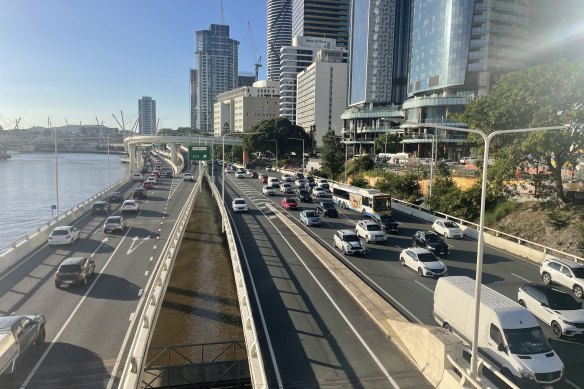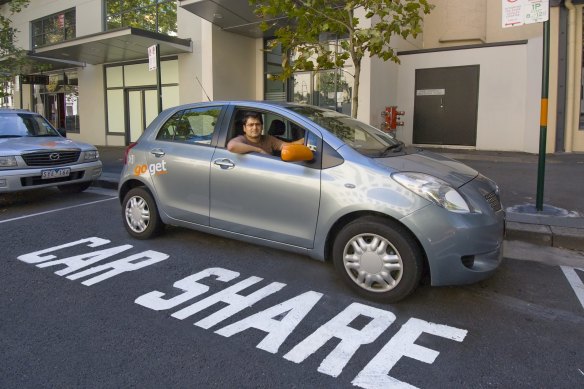- Perspective
- National
- Queensland
- Sharing economy
This was published 6 months ago
The unexpected ways car sharing could revolutionise Brisbane
Could you live without a car?
It’s not a popular hypothetical question but one I’ve asked myself often in the past year.
I live within 10 kilometres of the CBD and our office. I catch the bus to and from work every day and do groceries at the shopping centre at the end of my street. I have a bike and if my car is ever out of action, I can call on friends and family for a loan or lift.

Car sharing service GoGet has more than 3000 cars and vans for rent in Sydney, Melbourne and Brisbane. Credit: Amy Fraser
Other than weekends and moments of sheer laziness, my car sits on the street for most of the week, gathering dirt and costing me money.
To be honest, I don’t really want to give up my car. I don’t think I could live without one.
But I would consider car sharing.
Car sharing has existed in Australia since the early 2000s. But unlike Sydney and Melbourne, the movement has been slow to gain traction in Brisbane.
Christopher Vanneste, the head of space at leading Australian car sharing service GoGet, says that’s partly because of a lack of community awareness and dedicated infrastructure. “From other cities, we have seen that one of the largest enablers of car share is dedicated parking bays,” he says. “It becomes part of the city’s infrastructure.”
In Brisbane, car share operators can purchase permits for street parking – similar to residential parking permits. Brisbane City Council issued 38 permits in the past financial year but has no plans to allocate dedicated spaces, leaving drivers and users at the mercy of congested street parking.
On the upside, GoGet also operates out of residential buildings with a focus on sites with reduced parking requirements – which Brisbane will have more of in years to come.
In May, the council announced it would allow more developments in parts of the inner-city to be built with only half a car space, to reduce housing costs. Car parks can add up to $100,000 to the cost of an individual apartment. Removing this minimum requirement would free up more of the market where relief is desperately needed.

As Brisbane’s population grows, there’s only so many more cars and lanes you can add to roads and streets. Credit: Courtney Kruk
Improving affordable living is one of the reasons planning consultant and GoGet user Cameron Hoffmann started advocating for car sharing in 2009.
“The data says that every car share vehicle ends up removing the need for about eight to 10 associated cars,” he says. “It’s a very significant contributor to reduction in car parking demand.”
Hoffmann uses a “3.5 to 1” ratio to illustrate the demand on land and housing created by car ownership. A single car, he says, typically needs 3.5 car parks: at home, near or at work, and close to amenities such as the high street, shopping centre, cinema or local park.
“Cars aren’t satisfied with a single car park … we end up having about 100 square metres of car parking for every car. I multiplied that over south-east Queensland and [it equates to] 25,000 hectares of parking.”
It’s clear that measures to decentralise car ownership and wind back driver-centric infrastructure would benefit Brisbane residents. But such statements curry no favour in a city as car dependent as ours.
Browse the comments section on any infrastructure or transport story and you’ll quickly get a sense that if you come for cars, the people of Brisbane will come for you.
And perhaps that’s fair when it’s not been framed as an attractive opportunity that will benefit the entire city – which is why Rob Lucas, an organiser for urbanism collective Greater Brisbane, believes education is key. “The first thing is [educating people] that we’re not trailblazing,” he says.
“These problems have been solved before. When you’ve got issues with street space taken up by parking, there are many examples around the world of where they’ve reduced street sizes or removed parking and still been able to have active and vibrant communities without massive losses of personal freedoms.”

GoGet co-founder Bruce Jeffreys believes car sharing will only get bigger in Australia.Credit: GoGet
Car sharing, he says, can sit within a larger system that creates better outcomes for everyone. “Where you have to make compromises when you go down that road of denser living, it also comes with great advantages.”
If it seems impossible to imagine fewer cars in Brisbane, look no further than Paris. Through decades of dedicated urban planning and investment, they’ve not only reduced car use, but also seen a decline in car ownership. They have weaned off car dependency and allowed people to rediscover the not-so-radical alternative of public transit, cycling and walking.
Those wheels are already in motion for Brisbane, with Cross River Rail, the metro, 50-cent fares and improved active transportation across the city. Add car share to the CBD, suburbs and residential buildings, and in eight years time, I should have a different answer to the original question.